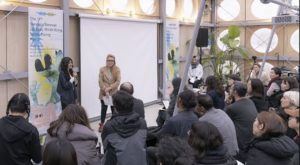13th Gwangju Biennale
Minds Rising, Spirits Tuning
February 26–May 9, 2021
The Artistic Directors of the 13th Gwangju Biennale, Defne Ayas and Natasha Ginwala, have announced further details of the forthcoming edition. Having launched the editorial platform of the Biennale, Minds Rising, and the online public programme with the forum GB Talks | Rising to the Surface: Practicing Solidarity Futures, Ayas and Ginwala are now pleased to announce 69 participating artists, 41 new commissions, and the exhibition venues in Gwangju, South Korea. The exhibition delves into a broad set of cosmologies, activating multitudinous forms of intelligence, planetary life-systems and modes of communal survival, as they contend with the future horizon of cognitive capitalism, algorithmic violence, and planetary imperialisms.
Participants (*denotes new commissions)
OS (Dmitry Paranyushkin and Koo Des)*, Pacita Abad, Korakrit Arunanondchai*, Katarina Barruk*, Farid Belkahia, Cecilia Bengolea, Seyni Camara*, Quishile Charan & Esha Pillay (aka The Bad Fiji Gyals), Yin-Ju Chen & Li-Chun Lin (Marina)*, Ali Cherri, Hyun-Taek Cho*, Vaginal Davis*, Cian Dayrit*, Emo de Medeiros, Patricia Domínguez, Theo Eshetu*, Gerard Fortuné, John Gerrard, Sonia Gomes, Trajal Harrell*, Femke Herregraven*, Lynn Hershman Leeson*, Tishan Hsu, Gözde Ilkin*, Jeong Kwan, Jumaadi, Karrabing Film Collective*, Sangdon Kim*, Sylbee Kim*, Timoteus Anggawan Kusno*, Kwak Duck-Jun, Gap-Chul Lee, Kangseung Lee*, Sangho Lee, Liliane Lijn, Candice Lin*, Vivian Lynn, Abu Bakarr Mansaray*, Angela Melitopoulos*, Ana María Millán*, Min Joung-Ki*, Ad Minoliti*, Moon Kyungwon*, MOON & JEON, Siyabonga Mthembu*, nasa4nasa*, Pedro Neves Marques, Kira Nova*, Fernando Palma Rodríguez*, People’s Archive of Rural India – PARI, Rajni Perera*, Outi Pieski*, Angelo Plessas*, Gala Porras-Kim*, Ana Prvački*, Judy Radul*, Sahej Rahal*, Zofia Rydet, Jacolby Satterwhite, Arpita Singh, Tcheu Siong, Chrysanne Stathacos*, Alexandra Sukhareva, Shannon Te Ao, Sissel Tolaas*, Cecilia Vicuña*, Ouattara Watts, Shen Xin*, Tuguldur Yondonjamts*
Partnership with Historical Collections:
Minds Rising, Spirits Tuning enquires into the rituals of Korean Shamanism, especially the role of female shamans in healing communal trauma, patriarchal violence and illness. Modes of kinship between humans, with the “beyond human” world(s) and the landscape ecologies of the Korean peninsula are assembled through artifacts from the collections of The Museum of Shamanism and The Gahoe Museum of Folk Painting in Seoul. Through a selection of manuscripts and paintings from the Wellcome Collection (London) mappings of the diseased body and personified organs are projected; and the Biennale integrates these broader cultural ontologies of health and systems of cure throughout the gradient of life and death.
Biennale Venues:
The Gwangju Biennale Exhibition Hall brings together over 50 artists and thinkers including Candice Lin, Lynn Hershman Leeson, Ana María Millán, Jacolby Satterwhite, Vaginal Davis, Bad Fiji Gyals, Arpita Singh, Seyni Camara, Fernando Palma Rodríguez, John Gerrard and key figures from the contemporary cultural community in South Korea such as Kangseung Lee, Moon Kyungwon and Jeon Joonho, Sangho Lee and Min Joung-Ki, amongst others. Artworks and loans from historical collections conjure sensorial entryways into the present while inviting audiences to experience commemorative aesthetics, indigenous life worlds, legacies of militarism, and strategies of survival composed by matrilineal collectivities and queer cultures; laying bare the groundwork of collective intelligence in a networked society. Gwangju National Museum unveils a dialogue with conceptions of death and the afterlife, as well as acts of mourning, through newly commissioned works by Theo Eshetu, Trajal Harrell, Gala Porras-Kim and Cecilia Vicuña. In the Gwangju Theater, Korea’s oldest operational cinema, Karrabing Film Collective activate their cinematic aesthetics through improvisation and hip-hop while facing up to the challenges of toxicity and conceiving forms of sovereignty against settler violence; and Judy Radul challenges the concept of visual perception and “the image”, in a technological and biological sense, by pointing thermal cameras at a live performing orchestra, surrounded by photomontages by Zofia Rydet that chart a surrealist dialogue with the theatre’s cinematographic history. At Yangnim, a sacred mountain previously used as a site for sky burials and currently the base of a Christian cemetery, Horanggasy Artpolygon hosts new commissions by Korakrit Arunanondchai, Sissel Tolaas and Sahej Rahal alongside recent works by Patricia Domínguez and Sangdon Kim, invoking pluralistic mythologies, sentient memories from the 4.3 Jeju uprising and techno-animistic kin.
Live Organ
Exclusively conceived for online audiences, newly commissioned works by Ana Prvački, Kira Nova and nasa4nasa, among others, explore individual and collective expression, protocols of intimacy and codes of spontaneity and are presented in the forms of episodes and web series on social media channels and streamed on the Biennale’s website.
GB Talks | Rising to the Surface: Practicing Solidarity Futures
The ongoing public program initiative leading up to the opening of the 13th Gwangju Biennale marks the 40th anniversary of the Gwangju Uprising. Online and on-site sessions will focus on algorithmic violence and digital surveillance; struggles to protect land and waters from extractive infrastructures; and the feminist legacy of democratization movements from the 1980s onward. Follow online events HERE.


